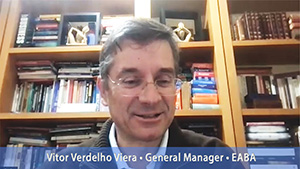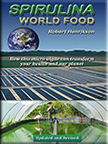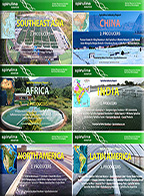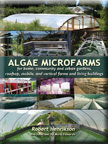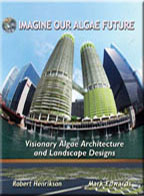Vitor Verdehlo
General Manager • European Algae Biomass Association
video recorded November 20, 2023
Summary: Vitor Verdelho Vieira is General Manager at European Algae Biomass Association, Member of the Board and Shareholder, – co-founder at A4F-Algae for Future, a leader in mocroalgae technologies, and co-founder at PhytoBloom. He started his first microalgae biotech company Necton in 1989. Now the company is a European leader in the production of traditional sea salt and microalgae for aquaculture and cosmetics. Vitor has developed and participated in more than 40 R&D projects and interacted with more than 200 different organizations in Europe.
Vitor explores the current development of spirulina and microalgae in Europe. Several hundred small companies are producing spirulina and reshaping the industry, with innovation in process and products, such as fresh and frozen spirulina or mixed in honey and bread. University courses teach spirulina entrepreneurship. He proposes microalgae protein should be compared with conventional protein using a nutritional score, not just prices. In the future there will be both small and large farms, and perhaps some very large farms in places like Saudi Arabia.
Robert Henrikson:
What would you say is the current situation of spirulina in Europe and worldwide?
Vitor Verdehlo:
Currently in Europe there are several hundred very small companies, family companies, most of them,centered in France,therefore they are called Spiruliniers. They produce between 500 kilograms and 2 tons per year. most of them solar dry their spirulina, and some of them sell fresh spirulina or frozen spirulina. This is reshaping the spirulina business. Some of them start very small,and then Some of them become bigger. They grow with their own resources. They are not usually based on big investment.
In Europe, spirulina production is expanding every year. In universities, there are entrepreneur courses. In each 20 ventures, one of them is a spirulina production facility, and it is known as an interesting business for young entrepreneurs. Because they have the opportunity to go from manufacturing to final product. So, business to consumer.
We have examples of spirulina companies all across Europe. In Germany, there are several in the north of Germany in many places it’s very cold. We have one spirulina producer in Latvia, that is a Baltic country. They have not only innovation in the final product, but also in the process, spirulina produced in photobioreactors.
For example, in italy, in some places where the climate is rather good, in the winter it can be cold, so they heat the water. They can produce much longer, eventually all the year. Innovation in product, innovation in process.
Robert Henrikson:
What do you see are the most interesting products?
Vitor Verdehlo:
There are basically two types of products. One is whole spirulina and just spirulina.
The other is a wide range of products, spirulina mixed with other things, which is possible specially with solar dried spirulina or fresh spirulina. Because with this kind of non-smelly and non-tasty spirulina, you can mix with other foods.
For example honey with spirulina. Honey is not a protein source. If you add spirulina, it can have lots of vitamins, lost of minerals, and protein. The most interesting of all is spirulina with bread. Because spirulina in bread can have a major impact. It requires some food engineering, but it’s a very, very interesting product.
I think that we can have two perspectives.
One, is the algae that can grow with sun. The photosynthetic algae: spirulina, chlorella, nannochloropsis and a group of maybe 20 algae. And then there is the group of algae that grow heterotropically, in fermenters, in very controlled environments: chlorella, euglena, clamydomonas, a group of maybe 10 algae. We can see these two big branches of application.
Robert Henrikson:
With spirulina, the costs of production are still pretty high. Competing with conventional protein sources, there’s a big gap.
Vitor Verdehlo:
The main issue is to change the analytic paradigm. You should not compare the different protein sources kilogram by kilogram. Because they have a different pack of amino acids and other compounds. You should compare the Nutri-Score, the nutritional score and not the kilogram. When you compare spirulina and soy – soy might be very cheap. If you produce in very very large scale, soy wins. It’s much more reasonable to compare the nutritional content.
Robert Henrikson:
If you look 10 years in the future, microalgae in Europe and the world, what do you see?
Vitor Verdehlo:
I see two ways.
The one that will sure happen, there will be many small businesses with added value with innovation in process, innovation in product. There will be small farmers and there will be large farmers.
The other possible future in ten years, maybe, there will be a few, very, very large scale facilities that will provide hundreds of thousands of tons of biomass. Spirulina might be one of them, grown in salt water.
Robert Henrikson:
What would be the locations?
Vitor Verdehlo:
Maybe in Arabic countries because they have the climate, they have the financial resources to do it large scale. They will be able to buy technology that already exists in many places of the world. eventually in africa it is also possible, but in Africa there are no financial resources.
We should not enroll in global statements like “algae will save the world”, “algae will be the protein of the future”. Algae will be part of it, for sure. Algae are very relevant already for the planet. When they provide us with photosynthesis, they provide with oxygen, they remove carbon dioxide from the atmosphere. They cover all ecosystems of the planet. There are algae everywhere.
Vitor Verdehlo • European Algae Biomass Association• www.eaba-association.org

